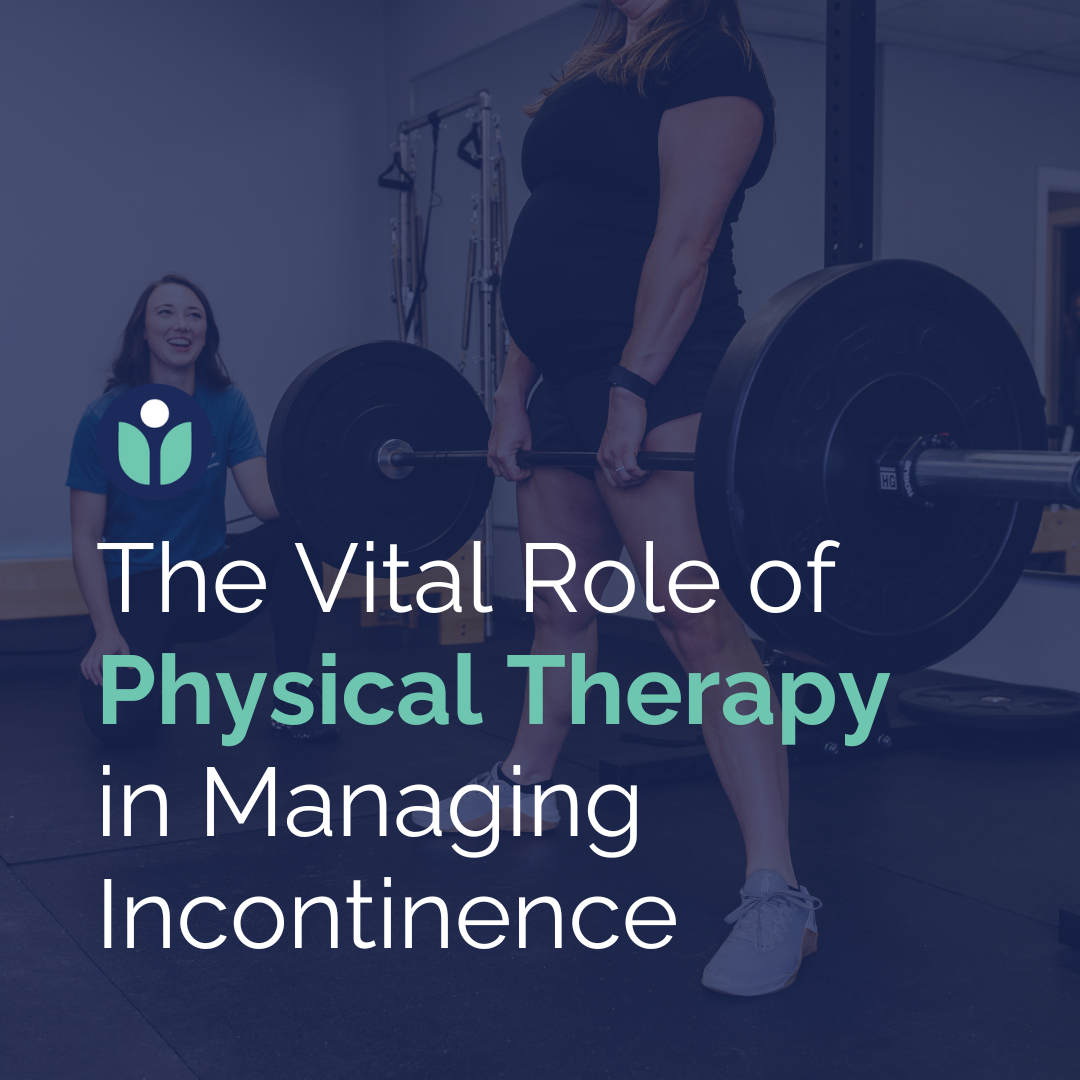The Vital Role of Physical Therapy in Managing Incontinence
The Vital Role of Physical Therapy in Managing Incontinence
Incontinence, or the involuntary leakage of urine or feces, is a common yet often stigmatized condition that affects millions of people worldwide. While medical and surgical interventions are available, physical therapy is increasingly recognized as a crucial, non-invasive approach to managing and often significantly improving incontinence.
Physical therapy is frequently recommended as a first-line treatment, focusing on the body’s natural ability to regain control and functionality.
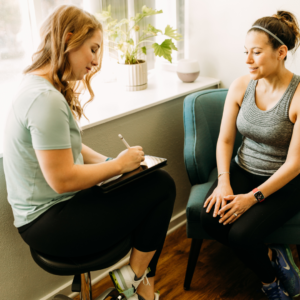
Your story matters. During every initial evaluation, we take the time to understand your history, concerns, and goals to create a treatment plan tailored to you.
Understanding Incontinence
Incontinence can result from a range of causes, such as:
-
- Aging: As we age, the pelvic floor muscles and surrounding tissues weaken, reducing control over bladder and bowel functions. This weakening can make it harder for the urethra and anal sphincter to remain tightly closed.
- In women, hormonal changes due to menopause can reduce estrogen levels, weakening the tissues around the bladder and urethra. Similarly, pregnancy hormones can lead to temporary changes in bladder control.
- Childbirth: Pelvic floor trauma from vaginal delivery, hormonal changes that soften tissues, and the physical pressure of a growing baby can all contribute to incontinence.
- Pelvic Surgeries: Surgical procedures involving the bladder, prostate, uterus, or rectum can impact the muscles and nerves responsible for continence.
- Chronic Constipation: Persistent constipation can strain pelvic floor muscles and lead to pelvic organ prolapse or weakening, both of which can contribute to urinary and fecal incontinence.
- Medications: Certain medications, such as diuretics, muscle relaxants, and sedatives, may increase the likelihood of leakage by either relaxing the bladder or increasing urine production.
- Lifestyle Factors: High intake of caffeine or alcohol, which are bladder irritants, can contribute to episodes of incontinence in some people.
- Aging: As we age, the pelvic floor muscles and surrounding tissues weaken, reducing control over bladder and bowel functions. This weakening can make it harder for the urethra and anal sphincter to remain tightly closed.
Incontinence generally falls into two categories:
-
- Urinary Incontinence: the involuntary loss of bladder control.
- Fecal Incontinence: the inability to control bowel movements.
We can even take it one step further and break down urinary incontinence into two different types:
- Stress Incontinence: This type occurs when physical stress or pressure on the bladder, like coughing, laughing, sneezing, or heavy lifting, causes leakage. Stress incontinence is often related to weakened pelvic floor muscles or a compromised support system around the bladder and urethra, commonly from childbirth or aging.
- Urge Incontinence: Also known as overactive bladder, this type of incontinence involves a sudden, intense urge to urinate, often followed by involuntary leakage. It can be due to nerve damage, bladder infections, or conditions affecting nerve signals, like multiple sclerosis or stroke, leading the bladder muscles to contract involuntarily.
Beyond the physical challenges, incontinence can also affect a person’s emotional well-being, social interactions, and overall quality of life, making comprehensive management essential.
The Role of Physical Therapy
Physical therapy (PT) offers a holistic, individualized approach to managing incontinence by focusing on the muscles involved in bladder and bowel control. Physical therapy primarily addresses pelvic floor health but also considers the core, hips, and trunk muscles.
Here are the core components of PT for incontinence:
1) Pelvic Floor Muscle Training
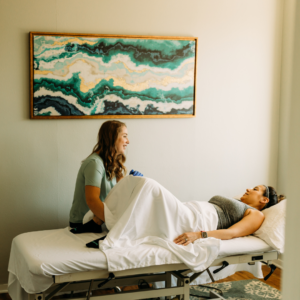
Your comfort is always our top priority. During an initial evaluation, our therapist carefully explains the process of an internal examination to assess pelvic floor function, ensuring that consent and communication guide every step.
One cornerstone of PT for incontinence is pelvic floor muscle training (PFMT), often associated with Kegel exercises. While Kegels can help strengthen the pelvic floor muscles, physical therapy goes well beyond these basic exercises.
Pelvic floor therapy is a multifaceted approach, using techniques that range from muscle strengthening to muscle relaxation, biofeedback, and core stability exercises to achieve full muscle coordination and functional improvement. A trained therapist may also incorporate advanced techniques like manual therapy, breathing exercises, and postural adjustments, all of which address the pelvic floor in context with the surrounding core, hip, and back muscles. This comprehensive approach ensures that treatment is highly individualized, aiming not just to strengthen but also to optimize muscle balance and body mechanics for sustained control over continence.
Benefits of Pelvic Floor Muscle Training:
- Increased Muscle Strength: Strengthening pelvic floor muscles provides additional support for the bladder and rectum, helping to reduce the frequency and severity of incontinence episodes.
- Note: For some, muscle relaxation may be prioritized over strengthening.
- Improved Muscle Coordination: Training helps improve the timing and coordination of muscle contractions, which is essential for maintaining continence.
- Enhanced Awareness: Patients gain better awareness and understanding of their pelvic floor muscles, which improves control and empowers them with more effective self-management.
2) Biofeedback
Biofeedback is a technique that helps individuals gain awareness and control over their bodily functions. During biofeedback, special sensors or devices provide real-time feedback on muscle activity, allowing patients to understand and refine their movements.
Benefits of Biofeedback:
- Visual and Sensory Feedback: Patients receive immediate feedback, ensuring they are activating the correct muscles during exercises.
- Personalized Training: Biofeedback allows for tailored exercises based on individual muscle activity and strength.
3) Behavioral Modifications
Behavioral strategies complement muscle training by focusing on lifestyle habits that support continence. Physical therapists may guide patients in bladder training techniques, such as scheduled voiding, urge suppression strategies, and dietary modifications.
Benefits of Behavioral Modifications:
- Increased Awareness of Triggers: Patients learn to identify and manage triggers for incontinence, such as dietary irritants or stress.
- Improved Bladder and Bowel Habits: Techniques like timed voiding encourage predictable, manageable schedules, while hydration and diet adjustments can help prevent bladder and bowel irritation.
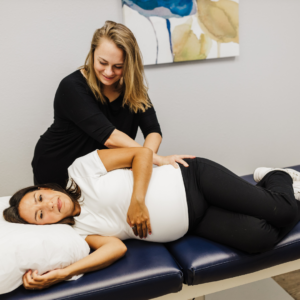
Movement matters, especially during pregnancy! Our therapist is testing lumbopelvic mobility to ensure comfort and proper range of motion, helping this mom-to-be feel her best.
4) Restore Lumbopelvic Mobility
Optimizing the mobility of the pelvic floor and surrounding lumbopelvic region can significantly impact incontinence management. For some individuals, restricted mobility in these areas exacerbates symptoms. Physical therapists use manual mobilization and mobility exercises to address these restrictions.
Benefits of Lumbopelvic Mobility:
- Improved Body Awareness: Improved mobility helps patients better identify and manage the resting state of their pelvic floor muscles, often enhancing relaxation.
- Optimized Muscle Length: Restoring optimal muscle length allows existing strength to be used more effectively, reducing incontinence episodes.
5) Hip, Core, and Postural Strengthening

Core and hip strength go hand in hand! Our therapist is helping this patient engage her muscles and build stability using the Pilates reformer. A stronger core = better pelvic health.
In addition to pelvic floor exercises, physical therapy often includes strengthening the hip and core muscles, as well as improving posture. A well-supported core and a balanced muscular system in the lumbopelvic area reduce pressure on the bladder and rectum, easing the load on the pelvic floor.
Benefits of Core & Hip Strengthening:
- Enhanced Core Stability: A strong core helps distribute abdominal pressure more evenly and supports pelvic floor function.
- Better Posture: Proper posture reduces strain on the pelvic floor, improves overall bodily function, and can reduce the impact of common comorbidities such as back pain and hip pain.
Additional Strategies & Support
For many, physical therapy is just one part of a comprehensive approach to managing incontinence. A pelvic floor therapist may recommend additional strategies, including:
- Lifestyle Changes: Diet, hydration, and stress management are all integral to bladder and bowel health.
- Assistive Devices: In some cases, physical therapists may suggest using pelvic floor support devices or external biofeedback tools at home.
- Collaboration with Other Specialists: Some individuals benefit from a team approach involving specialists in urology, gastroenterology, or psychology to provide a well-rounded treatment plan.
Impact on Quality of Life
The benefits of physical therapy extend far beyond physical improvement. Many patients report a renewed sense of confidence, decreased anxiety, and an enhanced quality of life. By addressing the root causes and symptoms of incontinence, physical therapy empowers individuals to regain control over their bodies, helping them live with greater independence and peace of mind.
When to Seek Help
If incontinence symptoms are interfering with daily life, it may be time to consider professional intervention. Seek help if you experience any of the following:
- Persistent Leakage: Involuntary leakage occurs frequently, particularly if it disrupts your daily activities or sleep.
- Inability to Control Urges: Struggling to reach the bathroom in time can indicate that therapy might be beneficial.
- Pain or Discomfort: Pain during urination, bowel movements, or even during exercises may be related to pelvic floor issues.
- Social and Emotional Impact: When incontinence affects your social life, emotional well-being, or overall quality of life, professional help can provide effective support and relief.
A physical therapist specializing in pelvic health can evaluate your condition and create a tailored treatment plan to address the specific causes and symptoms of your incontinence.
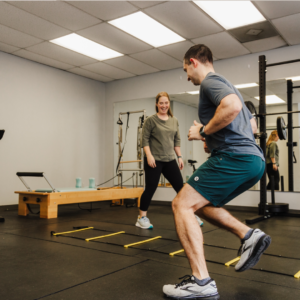
Returning to fitness after discomfort? Our therapist is here to guide this patient through a workout designed to rebuild strength and get him back to pain-free movement.
In Conclusion…
Physical therapy is a valuable, often life-changing tool in the management of incontinence. With a comprehensive approach that includes targeted exercises, biofeedback, behavioral strategies, and core strengthening, PT helps individuals build strength, improve muscle control, and make lasting changes. If you or someone you know is struggling with incontinence, consider consulting a physical therapist specializing in pelvic health. While each journey is unique, the support and personalized care provided by physical therapy can make all the difference, helping you regain control and improve your quality of life.
Contact Us
UpLift Physical Therapy Website
Phone: 210-468-7398
Follow us on social media: Instagram @upliftptp

